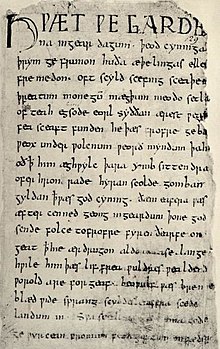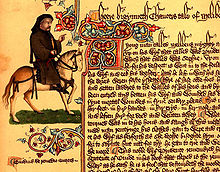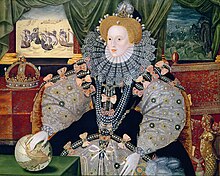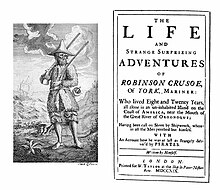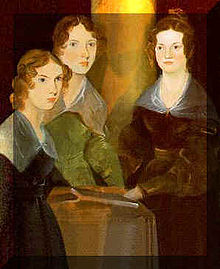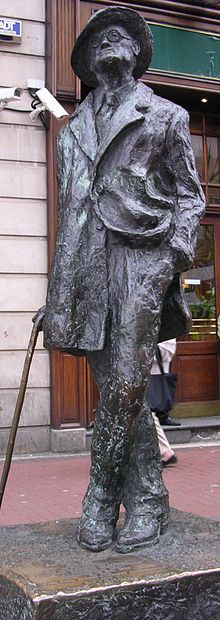English literature
English literature is generally used to mean not just the literature of England , but all literary production of Great Britain (historically including Ireland ) in the English language ; the term "British literature" is quite uncommon.
There are many overlaps with the English-language literatures of other countries, such as former British colonies such as Australia or Canada, but since the 19th century American literature in particular has been understood as a national literature that is different from English . English literature is the subject of research in English studies .
Old English literature (500–1150)
- Poetry: The Dream of the Rood
- Dramatic: –
- Epic: Beowulf
The phase of Old English literature extends to around 1150 (whereby one line of tradition even continues to 1250). The Dream of the Rood , a short religious poem written around the year 700, depicts the Crucifixion through the lens of Christ's Cross, which appears as an overwhelming symbol to a nocturnal visitor.
Beowulf , the oldest epic poem in English literature, is written before the 10th century. The work describes in alliteration the adventures of a great 6th-century Scandinavian warrior .
Middle English Literature (1150–1500)
- lyric:
- Drama: Mystery Plays , Morality Plays (Everyman)
- Epic: Brut. Geoffrey Chaucer ( Canterbury Tales ), Thomas Malory
The Norman conquest of 1066 brought a French-speaking upper class to the country, and Middle English emerged from the fusion of the Anglo-Saxon vernacular and French at court and aristocracy. One of the most important differences: the inflectional endings are omitted, and in most cases this changes the number of syllables in the words: the two-syllable knightes becomes the monosyllabic knights , a development with very serious consequences for the verse.
The classics of the Middle English phase are still the centerpiece of an English study today, in particular the Canterbury Tales , which Chaucer wrote between 1387 and 1400. In the framework story about 30 pilgrims travel from a London suburb to Canterbury to make a pilgrimage to the grave of Archbishop Thomas Becket .
Brut is a chronicle and chronicles British history from its mythical foundation by Brutus to the 15th century. It survives in nearly 200 Middle English manuscripts, plus dozens of Anglo-Norman and Latin versions.
In this phase there were no dramas in the later Shakespearean sense, but only the native forms of mystery play (dramatization of biblical episodes), morality play (allegorical representation of the struggle of virtues and sins for the soul of man) and interlude (courtly further development of the morality play with humanistic and political content). There were also folk festival traditions (masquerades, carnival, etc.).
Renaissance (1500–1649)
- Poetry: Thomas Wyatt , Philip Sidney , Edmund Spenser , John Donne (cf. metaphysical poetry )
- Dramatic: Ben Jonson , Christopher Marlowe , William Shakespeare , John Lyly , Thomas Kyd
- Fiction: Thomas More , Philip Sidney, Walter Raleigh (" School of Night ")
The most important political change of this period is reflected in English Renaissance literature: the Tudor kings Henry VII (1485–1509) and Henry VIII (1509–1547) succeeded in achieving extensive centralization against the high nobility and the church to assert power at court. Henry VIII made himself the head of the new Anglican Church .
Elizabeth I ruled England from 1558 to 1603; England prospered under their rule, which was expressed, among other things, in the rich literature of the Elizabethan era, of which William Shakespeare was the most important representative.
She continued the struggle of Henry VIII, her father, against Catholicism; at the same time she promoted music, fine arts and literature. During her reign England experienced a tremendous cultural boom. Elizabeth I was succeeded by James I (England) (reign: 1603–1625), son of Mary Stuart . In summary, one speaks of the Elizabethan-Jacobean literature. James I was succeeded by his son Charles I (reign: 1625–1649). His reign is referred to as the Caroline Period (cf. Caroline Poetry ). Some English poets who had their prime creative period during the reign of Charles I are also referred to as cavalier poets .
At the end of the Middle Ages (around 1500), the European vernaculars emerged from their inferior position to Latin in literature . The more recent English literature is therefore naturally much richer and more varied than that of the earlier phases of Old and Middle English.
In the early phases of European literature, verse was still dominant in all three literary genres – poetry, drama and fiction. As long as stories were not read in books but were passed on orally , the verse served as a mnemonic.
This tradition was broken for the first time with the invention of the printing press. After a stay in Bruges, William Caxton learned the art of printing in Cologne from 1471 to 1472 and in 1474 printed the Recuyell of the historyes of Troye by Raoul Le Fevre , which he had translated from the French, as well as The game and playe of the chesse , a translation of the work by Jacobus de Cessolis , as the first English language books. In 1480 he printed the Brut Chronicle (see above).
From then on, stories were written in prose all over Europe . Verse continued to dominate in lyric poetry, as it did in drama (cf., e.g., the works of William Shakespeare ). Only in the 20th century did drama become entirely prosaic.
In narrative literature, John Lyly founded euphuism with an extremely mannered style . B. was imitated by Robert Greene (1558-1592).
At the same time the courtier Philip Sidney was writing his works. In Italy he was impressed by Petrarch -style sonnets and published his own set of sonnets in 1591, which sparked a sonnet-mania.
Sidney's friend Edmund Spenser wrote the greatest epic poem of the age: Faerie Queen , referring to Elizabeth I.
The Elizabethan world view is of fundamental importance for the interpretation of Elizabethan literature.
Republican period ( Commonwealth and Protectorate ) (1649–1660)
- Poetry: Andrew Marvell (cf. metaphysical poetry )
- Drama: -
- Fiction: John Milton
This short phase of English literature is marked by the time of Oliver Cromwell . In Cromwell's time, public theatrical performances were forbidden. Therefore, no noteworthy dramatic works were created during this time.
John Milton supported Cromwell 's policies and publicly advocated the beheading of Charles I. His epic poem Paradise Lost is best known .
Restoration ( Restoration ) (1660–1700)
- Poetry: Samuel Butler , John Dryden , John Wilmot, 2nd Earl of Rochester
- Drama ( Restoration Comedy ): William Congreve , John Dryden , William Wycherley
- Narrative Fiction: Aphra Behn , John Bunyan
In 1660 Charles II (reigned 1660–1685) brought about a restoration of the Stuarts , during which the Puritans were once again excluded from the nation's political life for a long time. Theatrical performances, banned under Cromwell (see above), were allowed again after the restoration of the monarchy under Charles II, by the regent himself. The very liberal type of Restoration Comedy emerged , whose popularity only drastically decreased around 1700. At the same time, a woman became a professional playwright for the first time during this period: Aphra Behn .
Classicism and Enlightenment ( Neoclassicism and (Age of) Enlightenment ) (1700–1780)
- Poetry: Thomas Gray , Samuel Johnson , Alexander Pope , Montagu
- Dramatic: Susanna Centlivre , John Gay , Oliver Goldsmith , Eliza Haywood , Richard B. Sheridan
- Epic: Daniel Defoe , Henry Fielding , Samuel Richardson , Laurence Sterne , Jonathan Swift
Also referred to as the Augustan Age because - unlike German classicism, which particularly worships Greek antiquity - many authors imitated the Roman authors Virgil and Horace from the time of Emperor Augustus .
The Age of Enlightenment was marked by turbulence, in which the government machine and the economic mentality of modern bourgeois democracy were formed (eve of the French Revolution). The English institutions at this time became the model for the propagandists of the French Enlightenment.
During this period, the reigns of the last Stuart Queen Anne (1702-1714) and the kings of the House of Hanover George I (1714-1727), George II (1727-1760) and George III. (1760-1820).
The first Georges were more interested in their Electorate of Hanover than in English politics; George I did not even speak English and had to communicate in Latin with his first minister. In this way, the office of prime minister was formed in order to maintain the ability to govern.
The first great Prime Minister was Robert Walpole , who secured his government through a system of corruption and bribery. The system of robinocracy (derived from Walpole's first name) played an extremely important role in literature: almost all important writers of the time polemicized against it and were involved in factional struggles. Issues of contention were freedom of the press and speech and the publication of parliamentary speeches.
What is decisive for literature is that a bourgeois public emerged at the beginning of the 18th century. If writers had hitherto written for courtly taste and for the glory of noble patrons, they were now increasingly writing for bourgeois taste and also for a market. Accordingly, the bourgeois art genre of the novel also emerged during this period .
During this time, the first realistic novel in world literature, Robinson Crusoe , was published in England in 1719. In this developmental novel, Daniel Defoe shaped the realistic style of detailed description. The familiar routine actions of daily life suddenly no longer seem natural; the era of realism and the novel begins .
Also a travel novel, but in reality a political satire in disguise is Gulliver's Travels by Jonathan Swift (1726). It demonstrates the shift from 17th-century pessimistic anthropology to 18th-century optimism .
Samuel Richardson founded the genre of the epistolary novel with the enormously influential works Pamela (1740) and Clarissa (1748) . The novel narrative form made it possible to present feelings and experiences more directly. In both books, a virtuous girl from the bourgeoisie has to defend herself against the indecent pursuits of an immoral nobleman. Clarissa is considered to be the basic model of the seduction novel. Behind the story lies a critique by the growing English bourgeoisie of the nobility and their loose "French" customs. Richardson introduces the new myth of love marriages as opposed to arranged marriages ; the Age of Sensibility begins with his novels . Richardson's character configuration (drooling nobleman vs. asexual, virtuous young girl) dominated literature for the next 150 years: This motif can also be found in a modified form in the Romantic period in Jane Austen's Pride and Prejudice and in the Victorian phase in Charlotte Bronte 's Jane Eyre .
Due to its emotional charge, this new form of literature seduced you to experience it; the clergy, however, were very sympathetic to her, as literature now glorified virtue.
Even the writing of novels itself became a literary subject; the most prominent example is Laurence Sterne 's humorous novel Tristram Shandy .
See also : Will's Coffee-house and Button's Coffee-house
Romanticism ( 1780–1837 )
Unlike on the continent, Romanticism in Britain is less an organized movement than a very diffuse, unorganized stream of literature. Similar to Germany or France, for example, it expresses itself through an increased interest in nature, especially in its wilder, more untouched manifestations. A negative view of civilization, progress and pure reason is contrasted with a glorified image of the natural man ( noble savage ), a mystified and glorified view of history, the emphasis on natural genius and subjective feelings, the freely and individually lived out spontaneity and the power of imagination; the sphere of pure rationality is criticized in favor of the subconscious and supernatural. Often the unspoilt childishness is contrasted in a positive way with the negatively perceived constriction of adult life (as for example in William Blake : The Schoolboy ). The organized ecclesiastical practice of religion often gives way to a diffuse pantheism, which is often found in romantic poetry through personifications of nature and natural forces. The poet takes his personal feelings into nature, where he seeks solace, pursues introspective reflections in solitude, and sees his subjective feelings reflected in nature itself. Of particular importance to Romanticism is the idea of the sublime .
Important representatives of English Romanticism:
- Poetry: William Blake , William Wordsworth , Samuel Taylor Coleridge , Lord Byron , Percy B. Shelley , John Keats
- Dramatic: –
- Epic: Sentimental Novel. Gothic Novel , Walter Scott , Mary Shelley , Jane Austen , Maria Edgeworth
The literature of the Romantic period is to be seen against the background of the epochal upheavals in Europe 1789 : French Revolution . It is the time of revolutions, regicides and protests against the Creator.
The latter motif is reflected in a classic that is still frequently filmed today: Frankenstein (1818). Percy Shelley's wife, Mary Shelley, wrote it when she was 19. In Frankenstein , Ingolstadt Professor Frankenstein creates a monster; Many people mistakenly believe that the monster's name is "Frankenstein" and not the professor.
As an alternative to the consistently subjective perspective of the epistolary novel (see above), Jane Austen developed the authorial narrative perspective in the novels Emma and Pride and Prejudice : Sometimes we experience the story from the perspective of an important character, sometimes from an outside perspective on this character. Since then, the novel has been able to combine a psychological introspection and a social panorama. He suddenly showed how the individual and society are mutually dependent. Thus the novel became the dominant literary form of the 19th and 20th centuries, the literary form of bourgeois society.
Drama lay literally on its deathbed in the 19th century: no significant drama was created. The reason for this was that with the novel, literature had increasingly specialized in looking at the inner world. In addition, after the Licensing Act of 1737, there were only two theaters left in London (Drury Lane and Covent Garden), so that it became a museum and, above all, Shakespeare was played. It was not until the Theater Regulation Act of 1843 that the monopoly of the two patent theaters was lifted and a push for modernization (and drama production) began.
Victorian Era (1837–1901)
- Poetry: Elizabeth Barrett Browning , Robert Browning , Gerard M. Hopkins , Christina Rossetti , Dante Gabriel Rossetti , Algernon Charles Swinburne , Alfred Tennyson
- Drama: Henry Arthur Jones , Arthur Wing Pinero , Oscar Wilde
- Epic: Thomas Hardy , Brontë Sisters , Charles Dickens , George Eliot , Elizabeth Gaskell , Robert L. Stevenson , William M. Thackeray , Anthony Trollope , HG Wells , Sir Arthur Conan Doyle , Edward Bulwer-Lytton, 1st Baron Lytton .
The long reign of Britain's Queen Victoria (1837-1901) was a period of great technological and industrial advances. Great Britain established an extensive empire throughout the world , but in which many people remained poor. The authors of this era reflected their concerns that the human spirit could be destroyed by the machine age.
At the end of the 19th century, there finally came a far-reaching change in the collective attitude towards life in the large industrialized countries. He let belief in progress turn into expectation of war and horrific visions.
The most influential author of the Victorian phase was Charles Dickens; one of his most popular novels was Oliver Twist (1837–1839). Even historians have used Dickens' novels as a documentary source.
The Brontë sisters took up the Enlightenment motif of female virtue introduced earlier by Richardson (above) ( Jane Eyre , Wuthering Heights , The Lady of Wildfell Hall ) and also addressed impoverishment and social dependency.
Most clearly, but nevertheless dressed in the guise of a dystopia , HG Wells criticized the current social conditions: In his book The Time Machine (1895), the committed socialist described a country divided into decadent-idle Eloi (elites) and dark earthly Morlocks (proletarians) who come out of the holes at night and eat the Eloi. Note that Wells published his first novel in 1894 and his last in 1941; his work thus covers three phases of English literature: the Victorian phase, the Edwardian phase and the modern age.
Another defining author of the Victorian period was William Makepeace Thackeray, whose book Vanity Fair (1847–48) accurately described the manners and morals of his day.
Other novelists turned to adventure and romance: Robert Louis Stevenson wrote the pirate tale Treasure Island (1881) and the myth-making novel Dr. Jekyll and Mr. Hyde , in which a doctor is split into a good person and a bad person through a self-experiment.
At the same time, literature discovers her interest in history. Thus Thackeray's novel Henry Esmond deals with the fate of the last Stuarts . Walter Scott and Robert Louis Stevenson also wrote historical novels.
This period also saw two classic children's books: Rudyard Kipling wrote the children's stories The Jungle Book (1894/95), and Oxford professor Lewis Carroll wrote the nonsense classic Alice's Adventures in Wonderland (1865) and its follow -up Through the Looking-Glass (1872).
In poetry, Alfred Tennyson was a leader. Some of his poems deal with conflicting scientific and social ideas. Others deal with questions of patriotism.
Robert Browning wrote dramatic monologue poems in the form of speeches by imaginary characters, such as B. My Last Duchess (1842).
From the 1880s, the drama, which had already been believed dead, was revived: the authors made the crisis their subject. The difficulty of showing emotions from an outside perspective has now been addressed. The impossibility of describing society with the forms of private communication was demonstrated by the disruption of intimate milieus.
Edwardian Era (1901–1914)
- Poetry: Thomas Hardy
- Dramatic: John Galsworthy , GB Shaw , John Millington Synge , William Butler Yeats
- Epic: Arnold Bennett , Joseph Conrad , E.M. Forster , H.G. Wells
During the Edwardian period , the hedonistic "Joyful King" Edward VII reigned in England and Ireland . (1901-1910).
The most important "Edwardian" in literature was EM Forster (1879-1970). In the first decade of the 20th century, the Cambridge -educated Forster produced several novels in quick succession: Where Angels Fear to Tread (1905), The Longest Journey (1907), A Room With a View (1908). Howard's End occupies a special position : Here Forster contrasts the world of culture and commercialism. It shows that the harmonious combination of dichotomous positions ( prose - passion, culture - materialism, city - country ) fails.
In the Edwardian phase, the Victorian storytelling tradition continued to have an effect as far as possible. This is particularly true of the work of Arnold Bennett, HG Wells and John Galsworthy. The works of all three authors extend beyond the Edwardian phase into the modern age.
Arnold Bennett published almost fifty novels; with documentary precision he described the world of potteries in Staffordshire . At the center of his main work, the Clayhanger trilogy (1910, 1911, 1916), is Edwin Clayhanger, a character whose development is prevented by massive social conditioning.
In his cycle of novels The Forsyte Saga , John Galsworthy, who later won the Nobel Prize in Literature (1932), describes the rise and fall of the Forsytes, a family from the upper middle class . Galsworthy's conventional storytelling adopts almost all of the Victorian stylistic devices.
Modernism ( Modernism , 1914–1945)
- Poetry: WH Auden , TS Eliot , Wilfred Owen , Siegfried Sassoon , Stevie Smith , Dylan Thomas
- Dramatic: Noël Coward , William Somerset Maugham , JB Priestley
- Fiction: Elizabeth Bowen , Ivy Compton-Burnett , James Joyce , D.H. Lawrence , Dorothy Richardson , May Sinclair , Virginia Woolf .
Modernism begins in England with the First World War , during which the House of Saxe-Coburg and Gotha , which had ruled since the beginning of the 18th century, renamed itself the House of Windsor to distance itself from its German origins .
Another important break in the novel took place during this period: the switch to the experimental novel. Its characteristics included multi-perspectivity, fragmentation, hybridity, and disclosure of linearity and causality, and use of the stream of consciousness .
An epochal work of modernism was the experimental novel Ulysses by the Irish writer James Joyce. Joyce is considered the most radical innovator: never before has an author transported the reader so completely into another consciousness, where he perceives half-conscious memories, shadowed thoughts and unclear sensations mixed with images, smells and sounds.
Another exponent of the experimental novel was Virginia Woolf, who commented on the shift from traditional to experimental storytelling in several clairvoyant essays. She described HG Wells as a "materialist" and demonstrated the inadequacy of a prose that only registers meticulously while ignoring the depiction of mental interiors. It is necessary to replace a symmetrical, linear narrative style with one that does justice to the new view of life (“luminous”, “semi-transparent”). To distinguish him from the materialists , Woolf called Joyce a spiritualist .
Also assigned to the experimental novel is May Sinclair, who in turn first introduced the term "stream of consciousness" in a 1915 review of Dorothy Richardson's first work , Pointed Roofs (from her later cycle of novels, Pilgrimage ). Richardson published in this narrative technique before Joyce and Woolf.
The traditional novel lived on alongside it. He renewed himself thematically and was represented by Aldous Huxley ( Brave New World ), Ivy Compton-Burnett and the early Graham Greene .
DH Lawrence 's novels – formally also traditional – were written at a time when social attitudes towards women and sexuality were changing. Lawrence is also known as a precise portraitist of the British working class. However, his major literary theme was the hostility to the body of industrialized society and the question of how interpersonal relationships - especially relationships between women and men - can be lived in an industrialized society at all ( Sons and Lovers , 1913; The Rainbow , 1915; Loving Women , 1920 ; Lady Chatterley , 1928).
Also during this period, the genre of the modern short story (English short story ) was invented. Their authors were mostly novelists. In this genre, traditional forms of short prose were experimented with in order to design an aesthetic that does justice to the modern world. Important authors in this field are Katherine Mansfield , DH Lawrence, Virginia Woolf and Somerset Maugham , whose short stories are now more respected than his novels.
Although his most important novel was not written until 1949, George Orwell can also be classified as modern. By 1984 he created a dystopian novel of world literature.
Post -War Era after 1945
- Poetry: Eavan Boland, Wendy Cope , DJ Enright, Seamus Heaney , Ted Hughes , Philip Larkin, Paul Muldoon , RS Thomas
- Drama: John Arden, Samuel Beckett , Edward Bond , Caryl Churchill , Sarah Daniels, Pam Gems , Sarah Kane , Joe Orton , John Osborne , Louise Page, Harold Pinter , Mark Ravenhill , Peter Shaffer , Tom Stoppard , Timberlake Wertenbaker , Patrick Marber
- Fiction: Peter Ackroyd , John Banville , Pat Barker , AS Byatt , Angela Carter , Penelope Fitzgerald , Jane Gardam , Kazuo Ishiguro , Penelope Lively , David Lodge , Graham Swift , Jeanette Winterson, Margaret Yorke , Irvine Welsh .
According to experts, at least the prose of the last fifty years can hardly be structured in a meaningful way: the themes and forms of composition are too diverse. However, some time-bound trends can be identified.
In the 1950s, numerous novels took a critical look at the neo-conservative English class society. The young, mostly male, protagonists of these novels were referred to as angry young men , in reference to John Osborne's play Look Back in Anger (1956). Representatives of this trend were u. a. Alan Sillitoe and Iris Murdoch , and John Braine , whose novel Room at the Top paints a realistic portrait of post-war provincial England.
Also in the 1950s, as in the 1960s, the experimental form of the modernist novel was renovated. For example, William Golding , who later won the Nobel Prize for Literature, developed an image of man in his novels that deals with the culpable entanglement of the individual in a world that believes in progress, using an allegorical narrative technique.
From the 1970s, the feminist novel, also known as the women's novel, celebrated its triumphal march. Topics were feminism, female sexuality, marital problems and mother-daughter relationships. Also at this time, the genre of the post-war post-colonial novel, the postcolonial novel , began to boom. Here authors grappled with the decline of the Empire and reflected on the period of colonial rule.
Postmodernism since 1980
Since then, novelists have continued to produce new subgenres. In terms of content, they react to new trends and undermine established narrative conventions. As an early representative of postmodernism, John Fowles emerged as early as 1969 with his novel The French Lieutenant 's Woman .
The campus novel made a comeback in the 1980s with Howard Jacobson 's Coming From Behind (1983 ). As a result, Jacobson also wrote socio-critical to dystopian novels. The Finkler Question (2010) is a comedy-filled post - Holocaust novel for which Jacobson received the 2010 Booker Prize .
What is remarkable is the now uninhibited fictionalization of history, as it also takes place in feature films. Julian Barnes ' narratively innovative novel A History of the World in 10 ½ Chapters was a great success .
The combination of new narrative forms such as e.g. B. the metafictional storytelling , which are usually brought together with realistic narrative forms. An example of this is Ian McEwan's novel Atonement (2001).
Individual proofs and further information
- ↑ A detailed description of the most important English children's book classics can be found e.g. B.: Humphrey Carpenter: Secret Gardens: A Study of the Golden Age of Children's Literature. Houghton Mifflin, 1991, ISBN 0-395-57374-2 .
See also
- epoch (literature)
- The Cambridge History of English and American Literature
- List of English Language Writers
- Chronology of English Children's and Young Adult Literature
- English language poetry
literature
- Horst W. Drescher , Rüdiger Ahrens , Karl-Heinz Stoll : Lexicon of English literature (= Kröner's pocket edition . Volume 465). Kröner, Stuttgart 1979, ISBN 3-520-46501-9 .
- Willi Erzgräber : The English novel from Joseph Conrad to Graham Greene. Studies on the perception and representation of reality in English storytelling in the first half of the 20th century. UTB Francke, Tübingen/Basel 1999, ISBN 3-8252-1989-5 .
- Wolfgang Gehring: English subject didactics. An introduction. 2nd revised edition. Erich Schmidt Verlag, Berlin 2004, ISBN 3-503-06196-7 .
- Hans-Dieter Gelfert: Little History of English Literature . Verlag CH Beck, Munich 1997, ISBN 3-406-39281-4 .
- Christa Jansohn, Dieter Mehl, Hans Bungert: What should Anglophones and Americanists read? Berlin 1995.
- Eberhard Kreutzer, Ansgar Nünning (eds.): Metzler Encyclopedia of English-speaking authors . 631 Portraits – From the Beginnings to the Present. Metzler, Stuttgart/Weimar 2002, ISBN 3-476-01746-X .
- Thomas Kullman: William Shakespeare. Berlin 2005.
- Andrew Sanders: The Short Oxford History of English Literature . Clarendon Press, Oxford 2004, ISBN 0-19-926338-8 .
- Ralph Pordzik: The English Novel in the Nineteenth Century . Erich Schmidt Verlag, Berlin 2001.
- Hans Ulrich Seeber (ed.): English literary history . 5th edition. Verlag JB Metzler, Stuttgart 2012, ISBN 978-3-476-02421-3 .
- Annemarie Schöne: Outline of English literary history in tables. With an overview of the English style epochs by Wolfgang Schmidt-Hidding. Athenaeum Verlag, Frankfurt am Main and Bonn 1965.
- Peter Simhandl: Theater history in one volume. Henschel Verlag, 2007, ISBN 978-3-89487-593-0 .
